The gamma two-step cascade method at dalat nuclear research reactor
The event-event coincidence spectroscopy system was successfully established and operated
on thermal neutron beam of channel N0. 3 at Dalat Nuclear Research Reactor (DNRR) with resolving
time value of about 10 ns. The studies on level density, gamma strength function and decay scheme of
intermediate-mass and heavy nuclei have been performed on this system. The achieved results are
opening a new research of nuclear structure based on (n, 2) reaction.
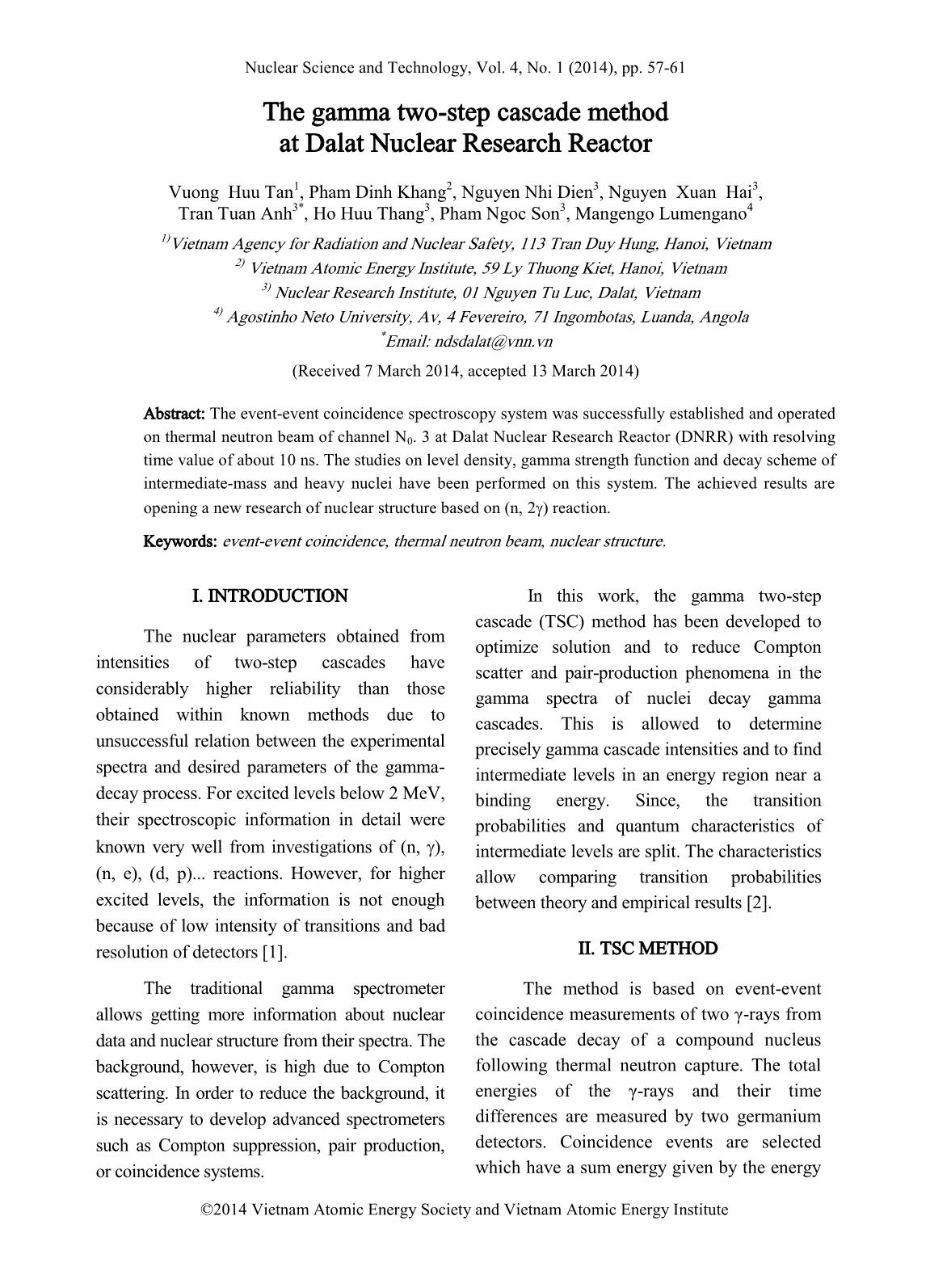
Trang 1
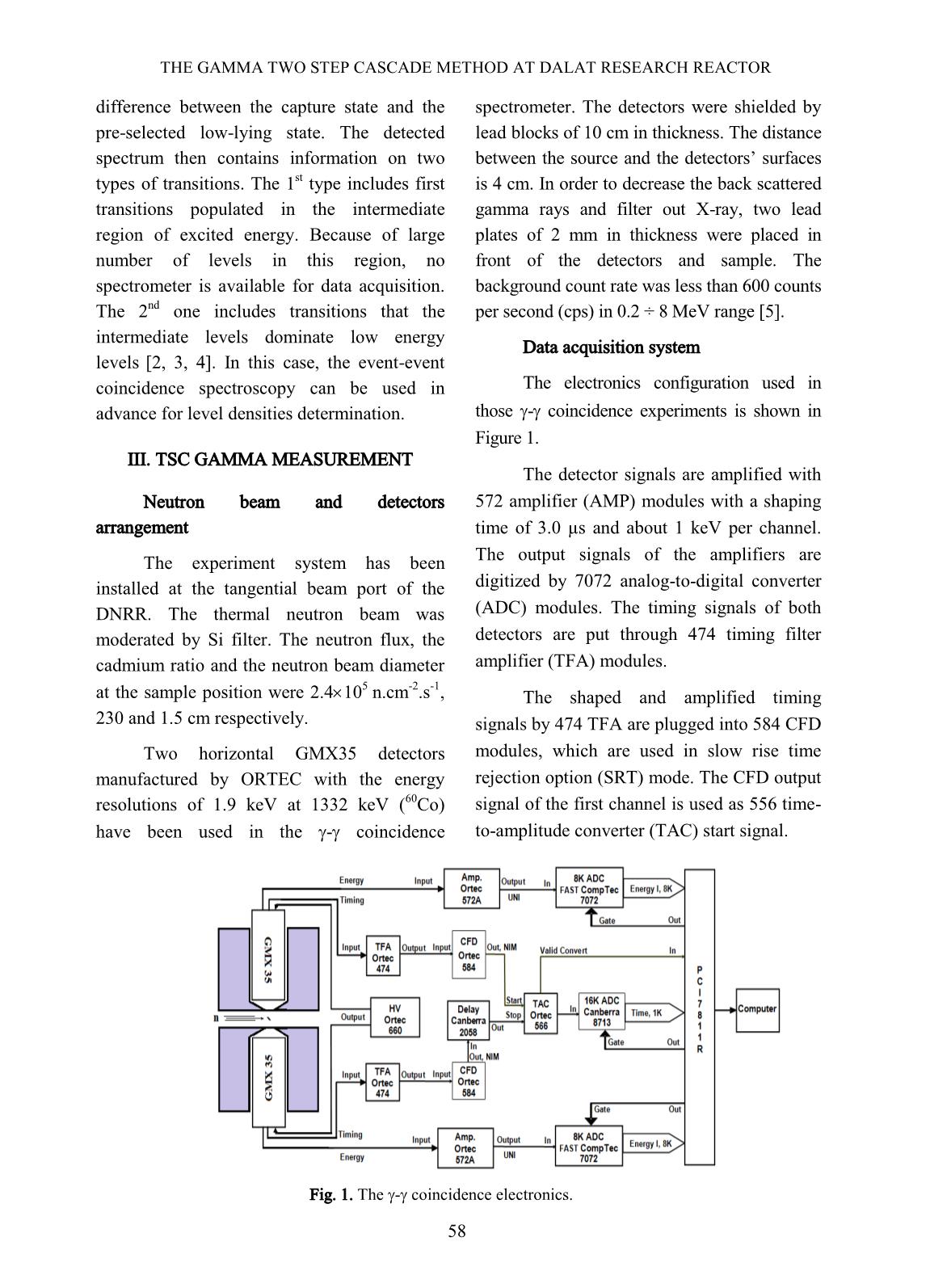
Trang 2

Trang 3
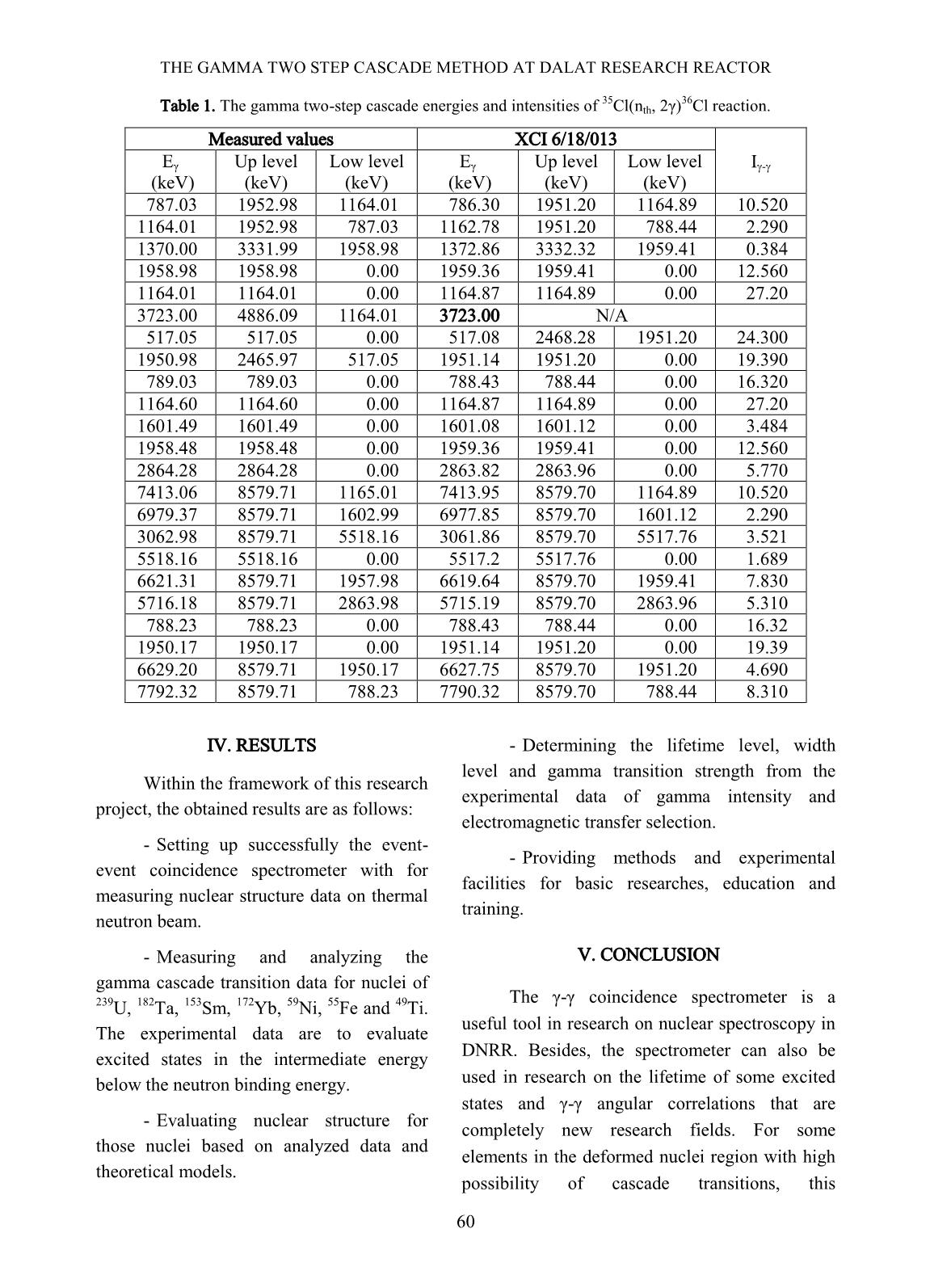
Trang 4
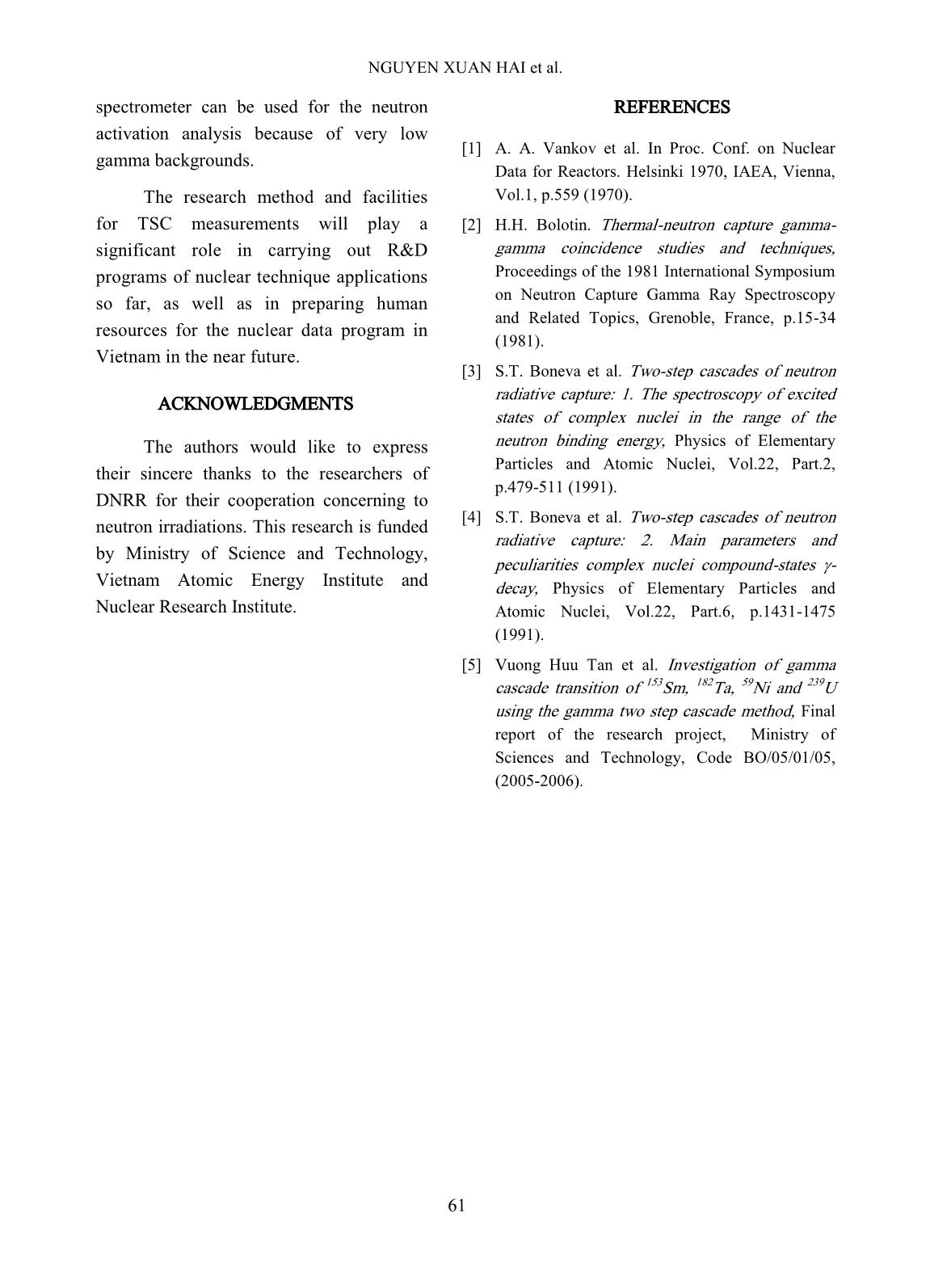
Trang 5
Bạn đang xem tài liệu "The gamma two-step cascade method at dalat nuclear research reactor", để tải tài liệu gốc về máy hãy click vào nút Download ở trên
Tóm tắt nội dung tài liệu: The gamma two-step cascade method at dalat nuclear research reactor
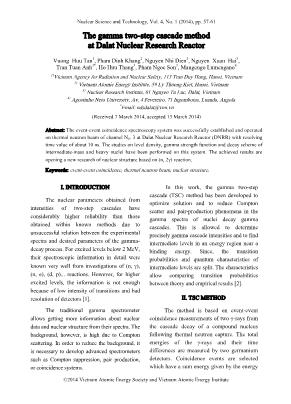
Nuclear Science and Technology, Vol. 4, No. 1 (2014), pp. 57-61 The gamma two-step cascade method at Dalat Nuclear Research Reactor Vuong Huu Tan 1 , Pham Dinh Khang 2 , Nguyen Nhi Dien 3 , Nguyen Xuan Hai 3 , Tran Tuan Anh 3* , Ho Huu Thang 3 , Pham Ngoc Son 3 , Mangengo Lumengano 4 1)Vietnam Agency for Radiation and Nuclear Safety, 113 Tran Duy Hung, Hanoi, Vietnam 2) Vietnam Atomic Energy Institute, 59 Ly Thuong Kiet, Hanoi, Vietnam 3) Nuclear Research Institute, 01 Nguyen Tu Luc, Dalat, Vietnam 4) Agostinho Neto University, Av, 4 Fevereiro, 71 Ingombotas, Luanda, Angola *Email: ndsdalat@vnn.vn (Received 7 March 2014, accepted 13 March 2014) Abstract: The event-event coincidence spectroscopy system was successfully established and operated on thermal neutron beam of channel N0. 3 at Dalat Nuclear Research Reactor (DNRR) with resolving time value of about 10 ns. The studies on level density, gamma strength function and decay scheme of intermediate-mass and heavy nuclei have been performed on this system. The achieved results are opening a new research of nuclear structure based on (n, 2) reaction. Keywords: event-event coincidence, thermal neutron beam, nuclear structure. I. INTRODUCTION The nuclear parameters obtained from intensities of two-step cascades have considerably higher reliability than those obtained within known methods due to unsuccessful relation between the experimental spectra and desired parameters of the gamma- decay process. For excited levels below 2 MeV, their spectroscopic information in detail were known very well from investigations of (n, ), (n, e), (d, p)... reactions. However, for higher excited levels, the information is not enough because of low intensity of transitions and bad resolution of detectors [1]. The traditional gamma spectrometer allows getting more information about nuclear data and nuclear structure from their spectra. The background, however, is high due to Compton scattering. In order to reduce the background, it is necessary to develop advanced spectrometers such as Compton suppression, pair production, or coincidence systems. In this work, the gamma two-step cascade (TSC) method has been developed to optimize solution and to reduce Compton scatter and pair-production phenomena in the gamma spectra of nuclei decay gamma cascades. This is allowed to determine precisely gamma cascade intensities and to find intermediate levels in an energy region near a binding energy. Since, the transition probabilities and quantum characteristics of intermediate levels are split. The characteristics allow comparing transition probabilities between theory and empirical results [2]. II. TSC METHOD The method is based on event-event coincidence measurements of two γ-rays from the cascade decay of a compound nucleus following thermal neutron capture. The total energies of the γ-rays and their time differences are measured by two germanium detectors. Coincidence events are selected which have a sum energy given by the energy ©2014 Vietnam Atomic Energy Society and Vietnam Atomic Energy Institute THE GAMMA TWO STEP CASCADE METHOD AT DALAT RESEARCH REACTOR 58 difference between the capture state and the pre-selected low-lying state. The detected spectrum then contains information on two types of transitions. The 1 st type includes first transitions populated in the intermediate region of excited energy. Because of large number of levels in this region, no spectrometer is available for data acquisition. The 2 nd one includes transitions that the intermediate levels dominate low energy levels [2, 3, 4]. In this case, the event-event coincidence spectroscopy can be used in advance for level densities determination. III. TSC GAMMA MEASUREMENT Neutron beam and detectors arrangement The experiment system has been installed at the tangential beam port of the DNRR. The thermal neutron beam was moderated by Si filter. The neutron flux, the cadmium ratio and the neutron beam diameter at the sample position were 2.4 105 n.cm-2.s-1, 230 and 1.5 cm respectively. Two horizontal GMX35 detectors manufactured by ORTEC with the energy resolutions of 1.9 keV at 1332 keV ( 60 Co) have been used in the - coincidence spectrometer. The detectors were shielded by lead blocks of 10 cm in thickness. The distance between the source and the detectors’ surfaces is 4 cm. In order to decrease the back scattered gamma rays and filter out X-ray, two lead plates of 2 mm in thickness were placed in front of the detectors and sample. The background count rate was less than 600 counts per second (cps) in 0.2 ÷ 8 MeV range [5]. Data acquisition system The electronics configuration used in those - coincidence experiments is shown in Figure 1. The detector signals are amplified with 572 amplifier (AMP) modules with a shaping time of 3.0 µs and about 1 keV per channel. The output signals of the amplifiers are digitized by 7072 analog-to-digital converter (ADC) modules. The timing signals of both detectors are put through 474 timing filter amplifier (TFA) modules. The shaped and amplified timing signals by 474 TFA are plugged into 584 CFD modules, which are used in slow rise time rejection option (SRT) mode. The CFD output signal of the first channel is used as 556 time- to-amplitude converter (TAC) start signal. Fig. 1. The - coincidence electronics. NGUYEN XUAN HAI et al. 59 The CFD output signal of the second channel is delayed 100 ns and served as a TAC stop signal. The full scale of TAC is set at 100 ns, and output signal is digitized in 8713 ADC with selection of 1024 channels for a 10 V input pulse. The TAC “Valid Convert” signal is used to gate 7072 ADCs, and the delay or synchronizing with AMP output signal is implemented by interface software. Recorded coincident events have three values, including coincidence gamma-ray energies from detector 1, detector 2 and time interval between two γ- rays in a pair event [5]. The resolving time for this configuration is about 10 ns with 60 Co source measurement (see Figure 2). Coincidence Data Processing In the experiment, the data, which contains all pairs of - coincidence data from two HPGe-detectors, were stored in the memory of computer. Indeed, that is pairs of channel numbers associated with energies of - coincidence pairs. The coincidence spectrum of each detector can be created from the corresponding data file by the procedure that the count number of each channel of the spectrum is equal to times of that channel appearing in the corresponding coincidence data file. The coincidence spectrum of one detector with the chosen peak in another detector can be created by the same procedure. They are coincidence spectra between high- energy primary and low-energy secondary transitions or among the low-energy secondary transitions as obtained in the work [3, 4]. Besides, the summation spectrum of amplitudes of coincidence pulses can be created by summation of pairs of coincidence data. Every full-peak in the summation spectrum is corresponding to the - cascade decays from the capture state to the determined low-lying excited level. The TSC spectrum of one detector associated with the defined energy (E) summation peak will be taken by choosing pairs of coincidence data having summation in the range of E ± E (with E/E ≤ 0.005) (see Figure 3). The TSC spectrum gives information on levels in the region between the capture state and the defined E low-lying level. From all obtained TSC spectra we can build up the decay scheme of the investigated nucleus on the base of methods and the criteria given in Ref. [5]. The measured values of gamma two-step cascade energies and intensities of 35 Cl(nth, 2γ)36Cl reaction were shown in Table 1. 0 10 20 30 40 0 1000 2000 3000 4000 5000 C o u n ts Resolving time (ns) 10ns Fig. 2. The resolving timing spectrum 2000 4000 6000 8000 0 100 200 300 400 500 E1+E2 = 8579 keV 7 8 8 .4 3 k e V 1 1 6 4 .8 7 k e V 1 6 0 1 .0 8 k e V 2 6 7 6 .3 0 k e V 2 8 6 3 .8 2 k e V 3 0 6 1 .8 6 k e V 5 7 1 5 .1 9 k e V 5 5 1 7 .2 k e V 5 9 0 2 .7 k e V 1 9 5 9 .3 6 k e V 6 9 7 7 .8 5 k e V 6 6 2 7 .7 5 k e V 7 7 9 0 .3 2 k e V C o u n ts Energy keV 7 4 1 3 .9 5 k e V Fig. 3. The TSC spectrum of 36 Cl belongs to final level from 8579 keV. THE GAMMA TWO STEP CASCADE METHOD AT DALAT RESEARCH REACTOR 60 Table 1. The gamma two-step cascade energies and intensities of 35 Cl(nth, 2γ) 36 Cl reaction. Measured values XCI 6/18/013 I- Eγ (keV) Up level (keV) Low level (keV) Eγ (keV) Up level (keV) Low level (keV) 787.03 1952.98 1164.01 786.30 1951.20 1164.89 10.520 1164.01 1952.98 787.03 1162.78 1951.20 788.44 2.290 1370.00 3331.99 1958.98 1372.86 3332.32 1959.41 0.384 1958.98 1958.98 0.00 1959.36 1959.41 0.00 12.560 1164.01 1164.01 0.00 1164.87 1164.89 0.00 27.20 3723.00 4886.09 1164.01 3723.00 N/A 517.05 517.05 0.00 517.08 2468.28 1951.20 24.300 1950.98 2465.97 517.05 1951.14 1951.20 0.00 19.390 789.03 789.03 0.00 788.43 788.44 0.00 16.320 1164.60 1164.60 0.00 1164.87 1164.89 0.00 27.20 1601.49 1601.49 0.00 1601.08 1601.12 0.00 3.484 1958.48 1958.48 0.00 1959.36 1959.41 0.00 12.560 2864.28 2864.28 0.00 2863.82 2863.96 0.00 5.770 7413.06 8579.71 1165.01 7413.95 8579.70 1164.89 10.520 6979.37 8579.71 1602.99 6977.85 8579.70 1601.12 2.290 3062.98 8579.71 5518.16 3061.86 8579.70 5517.76 3.521 5518.16 5518.16 0.00 5517.2 5517.76 0.00 1.689 6621.31 8579.71 1957.98 6619.64 8579.70 1959.41 7.830 5716.18 8579.71 2863.98 5715.19 8579.70 2863.96 5.310 788.23 788.23 0.00 788.43 788.44 0.00 16.32 1950.17 1950.17 0.00 1951.14 1951.20 0.00 19.39 6629.20 8579.71 1950.17 6627.75 8579.70 1951.20 4.690 7792.32 8579.71 788.23 7790.32 8579.70 788.44 8.310 IV. RESULTS Within the framework of this research project, the obtained results are as follows: - Setting up successfully the event- event coincidence spectrometer with for measuring nuclear structure data on thermal neutron beam. - Measuring and analyzing the gamma cascade transition data for nuclei of 239 U, 182 Ta, 153 Sm, 172 Yb, 59 Ni, 55 Fe and 49 Ti. The experimental data are to evaluate excited states in the intermediate energy below the neutron binding energy. - Evaluating nuclear structure for those nuclei based on analyzed data and theoretical models. - Determining the lifetime level, width level and gamma transition strength from the experimental data of gamma intensity and electromagnetic transfer selection. - Providing methods and experimental facilities for basic researches, education and training. V. CONCLUSION The γ-γ coincidence spectrometer is a useful tool in research on nuclear spectroscopy in DNRR. Besides, the spectrometer can also be used in research on the lifetime of some excited states and γ-γ angular correlations that are completely new research fields. For some elements in the deformed nuclei region with high possibility of cascade transitions, this NGUYEN XUAN HAI et al. 61 spectrometer can be used for the neutron activation analysis because of very low gamma backgrounds. The research method and facilities for TSC measurements will play a significant role in carrying out R&D programs of nuclear technique applications so far, as well as in preparing human resources for the nuclear data program in Vietnam in the near future. ACKNOWLEDGMENTS The authors would like to express their sincere thanks to the researchers of DNRR for their cooperation concerning to neutron irradiations. This research is funded by Ministry of Science and Technology, Vietnam Atomic Energy Institute and Nuclear Research Institute. REFERENCES [1] A. A. Vankov et al. In Proc. Conf. on Nuclear Data for Reactors. Helsinki 1970, IAEA, Vienna, Vol.1, p.559 (1970). [2] H.H. Bolotin. Thermal-neutron capture gamma- gamma coincidence studies and techniques, Proceedings of the 1981 International Symposium on Neutron Capture Gamma Ray Spectroscopy and Related Topics, Grenoble, France, p.15-34 (1981). [3] S.T. Boneva et al. Two-step cascades of neutron radiative capture: 1. The spectroscopy of excited states of complex nuclei in the range of the neutron binding energy, Physics of Elementary Particles and Atomic Nuclei, Vol.22, Part.2, p.479-511 (1991). [4] S.T. Boneva et al. Two-step cascades of neutron radiative capture: 2. Main parameters and peculiarities complex nuclei compound-states - decay, Physics of Elementary Particles and Atomic Nuclei, Vol.22, Part.6, p.1431-1475 (1991). [5] Vuong Huu Tan et al. Investigation of gamma cascade transition of 153Sm, 182Ta, 59Ni and 239U using the gamma two step cascade method, Final report of the research project, Ministry of Sciences and Technology, Code BO/05/01/05, (2005-2006).
File đính kèm:
 the_gamma_two_step_cascade_method_at_dalat_nuclear_research.pdf
the_gamma_two_step_cascade_method_at_dalat_nuclear_research.pdf

